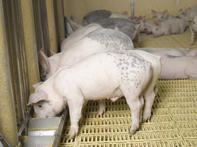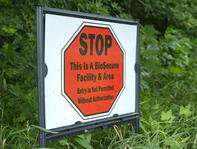
Genetics
Some pigs breeds weigh more at birth and grow faster than other breeds. The sows of some breeds also have more milk and better mothering qualities, resulting in their piglets growing faster and being healthier. So look at what is normal for the breed when establishing growth targets and comparing your production results with that of other farmers.
Many farmers use crossbreeding, in other words, a boar from one breed on a group of sows from another breed to get the best qualities from both breeds.
When doing this, all the offspring should be sold, since breeding with the offspring may result in all the negative qualities of the two breeds becoming enhanced in the second group’s offspring. When selecting breeding material, it is important to select animals that grow well and have good reproduction and meat qualities.
Malnutrition
Pigs may be growing poorly because they are not eating enough, the feed is of a poor quality, difficult to digest or unappetising, or because the pigs are not eating enough of the right things.
To avoid this problem, ask an animal health technician or dietician to help you formulate a feeding programme that meets all the nutritional requirements of your pigs at specific phases of production. Such a programme should not only consider the dietary requirements of pigs, but also feed sources that are readily available in your area and the cost of the raw materials.
In addition, you need to ensure the pigs have access to enough feed when they need it, whether the pigs are grazing outside or being produced in an intensive housing system. If the pigs are produced outside, the pigs should have access to supplements to bridge shortages in the grazing.
Farmers should also ensure that each and every pig has access to food by reducing competition at feeding troughs. This can be done by ensuring there is enough feeding space for each pig at feeding troughs. Food should be clean and fresh, besides presenting health risks, pigs otherwise might not want to eat it.
Parasites
External parasites, such as mange, lice, ticks and fleas, may cause such irritation that the pigs spend more time trying to relieve the irritation through scratching than eating, resulting in poor growth. Internal parasites, such as worms, will also cause poor growth.
Cleanliness in the production area will go a long way in combatting parasites. When there is a parasitic infestation, treat it as soon as possible to prevent it from spreading to other pigs.
It makes sense to treat pigs preventatively if a specific risk is high under your production conditions. Ask an animal health technician or veterinarian for advice.
Diseases

Environmental Conditions
Heat stress has a negative impact on feed intake, while cold stress will result in pigs eating more than usual in an attempt to warm themselves.
So, supply pigs with feed during the cooler times of the day and augment their feed with additional minerals to make up for nutritional losses during heat spells. Efforts should be taken to prevent, especially young piglets, from being too cold, as that will make them more vulnerable to diseases and result in poor growth.
By Glenneis Kriel